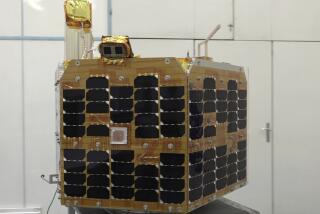Missile-Hunting ‘Star Wars’ Satellite Put in Orbit
- Share via
KENNEDY SPACE CENTER, Fla. — A Delta Star missile-hunting satellite thundered into orbit Friday in a key “Star Wars” test to develop a split-second defense against nuclear rockets.
The $140-million satellite is intended to aim its sensors at a series of missile and space launchings over several months to help perfect the technology for detecting and destroying enemy boosters within minutes after they leave their launching pads.
Researchers will seek to gather rocket exhaust data against the background of the North Pole region, an area through which attacking Soviet missiles would travel.
“All systems are working perfectly,” Air Force spokesman Ron Rand reported minutes after the 11-story-tall Delta vaulted off its launching pad after a secret countdown.
Rocket Performs Well
Forty-four minutes after liftoff, launching commentator Skip Mackey reported that the rocket had done its job and that the satellite had separated and was in orbit more than 100 miles above the Earth.
Air Force officials said that the Delta Star experiment is part of research being done for the Strategic Defense Initiative, also known as “Star Wars,” to develop a space-based missile defense system.
The three-ton satellite carries a laser radar, seven video imaging cameras and an infrared imager. A Laser Illumination Detection System is designed to spot ground-based laser firings, a capability that would permit future satellites to take evasive action.
Using a 48-jet thruster aiming system, Delta Star has the capability to maneuver into position to spot the blazing plume of missiles and rockets to be launched over the next several months from the space center; Wallops Island, Va.; White Sands, N. M.; Poker Flats, Alaska; Barking Sands, Hawaii, and, possibly, from Soviet launching sites.
Identifying Exhaust Signature
In addition to quickly sighting a rocket plume, Delta Star sensors are expected to gather information to help distinguish the exhaust signature from such backgrounds as land, ocean, horizon, space, atmospheric effects and the bright aurora borealis in the North Pole region.
The polar background information is critical because Soviet missiles would travel through that region in any attack on the United States.
The launching was the third in a series. In a 1986 test, two satellites tracked each other and one destroyed the other by crashing into it. Last September, a satellite tracked 15 simulated nuclear missiles released by the same rocket in a test aimed at detecting missiles in flight, after their motors have burned out.
More to Read
Sign up for Essential California
The most important California stories and recommendations in your inbox every morning.
You may occasionally receive promotional content from the Los Angeles Times.













